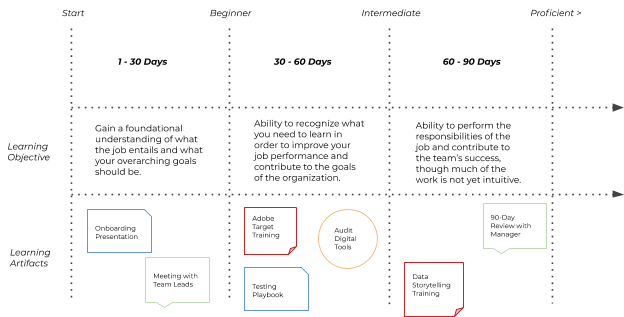
At Brooks Bell, we believe establishing a curiosity-driven culture is critical for creating adaptable organizations. Just as important to the creation of these cultures is onboarding new employees into them. Where do we begin as we design onboarding programs for our client’s new employees? Exactly where we begin all strategic engagements: understanding the people at the heart of the challenge.
Whether our team is conducting training, stakeholder interviews, or creative workshops, we always design our agenda by considering what our audience may come into the room (virtual or physical) thinking, feeling, or questioning. When newly hired employees are stepping into their new positions, their thoughts may include:
- What will my team expect of me?
- What are my core responsibilities for this job?
- What should my goals be, and who will help me set them?
- What resources do I have available while I’m getting started?
- What does it take to be successful in this role, on this team?
- Where can I make a difference, and will I be empowered to do so?
In summary, new team members are filled with uncertainty and doubt in the beginning days and weeks of their tenure, and it’s the job of an onboarding program to incrementally replace those feelings with confidence and know-how.
Many large organizations utilize a 30-60-90 day review process, so if your company does as well — even if it doesn’t — it might be helpful to use these dates as learning milestones to create an onboarding framework. Ask yourself what you’d like, or need, your new team member to achieve before each 30-day window is complete and what resources, meetings or activities need to be provided in order for them to do so successfully.
Maybe your framework begins to look something like this:

After establishing a rough framework we introduce our clients to the stages of learning, in which we move from having little awareness of what we don’t know (Unconscious Incompetence) to utilizing knowledge or a skill without having to actively think about what we’re doing (Unconscious Competence). Moving from one through to the other requires a thoughtful learning curriculum, much like a teacher would design for her class or hospitals for their residents. It should be no different, then, for new employees within your team.
The activity in designing an onboarding program centers around answering the following questions for yourself:
- What is it that I want my team member to learn, when should that happen, and what is the best way to deliver that learning?
- How will I know when they’ve done so successfully?
By answering these questions you’ll be able to start adding definition to your framework. You can add learning objectives for each 30-day period and begin to identify trainings, resources, meetings or activities, sequencing them in an order that best builds upon an employee’s existing knowledge and achieves the learning objectives you’ve set.
Your framework should begin to look a little something like this:

This curriculum view will also help identify resources, content or trainings you need but don’t yet exist, eg. Experimentation Playbooks, Data Interpretation and Storytelling Trainings, etc.
One last consideration to make with your onboarding curriculum is incorporating a continuous feedback loop. Not just one where the new employee receives feedback on their progress, but one in which the employees provide feedback on how successfully the onboarding program teaches the skills and expertise the role demands and prepares team members to make a positive impact within their department and across the organization.
We’ve been lucky enough to partner with our clients to design these onboarding programs for teams across organizations large to small, and even for ourselves. When employees join our team and realize there’s a structure in place, a plan that helps them move from doubt to confidence, those lingering questions and fears begin to dissipate and their contributions to their team and the organization in general soar.
Categories










